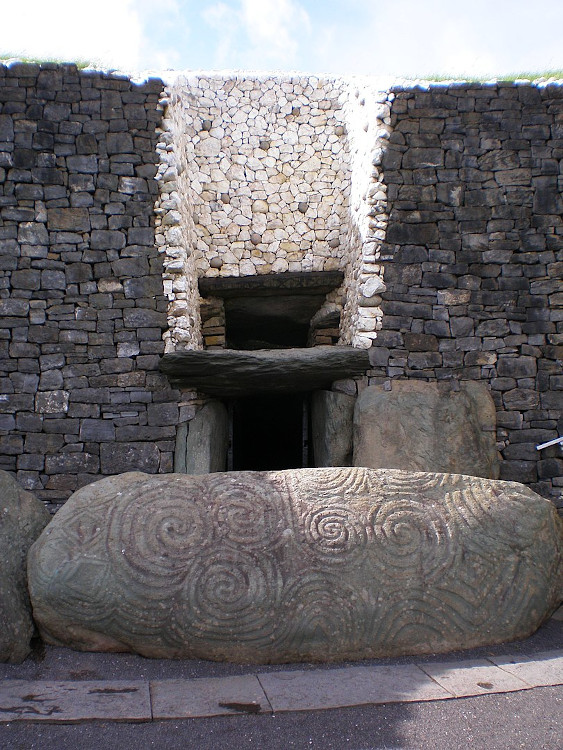In the apparent chaos of nature, early man recognized repeated shapes and signs. He perceived recurring geometries that revealed the presence of a divine order. Circles, triangles and squares defined the structure of matter, so in the flowers of the fields, in the mountains, in the bodies of living beings. Figures combining with each other manifested increasing degrees of harmony, hidden seeds of an intelligence governing the universe. Our ancestors identified the geometry of the spiral in the shells of some seashells, in the growth of shoots, in the coiling of snakes and even in the wave-like movement of waters.

The spiral of life
The spiral was always observed in animate beings or in what was in motion, in evolution. To Neolithic men it expressed the generative force of nature; it was a symbol of life. On the other hand, to their eyes the sun itself, the source of light and the heat necessary for survival, seemed to follow a celestial spiral trajectory1. Every day they watched the star rise in the east and set in the west. However, the trajectory was not always the same. At the summer solstice, the sun goes through a high curve over the horizon. So the duration of light is the maximum in the course of the year. Then this orbit gradually declines from day to day until it takes its shortest path in the winter solstice. From then on, the process reverses and the duration of light begins to increase again.
It can be imagined that for the ancients the sun was in motion relative to the earth. Especially they could believe that the star during the night passed under it, as the opposite points of rising and setting might suggest. The ancestors thus intuited the path of a double spiral, alternately winding and unwinding on itself. The annual path of the sun was precisely what established the cycles of life. Neolithic men, devoted to agriculture, well knew that nature is so alive when the solar spiral is broad in spring. Contrariwise, it has its moment of lowest activity coinciding with the winter solstice.

Symbol of death and rebirth
The spiral manifested in nature in association with the vital, the existing. Therefore, the ancients adopted this symbol to express life and evoke it when needed, to make it present through ritual and sign. We can only speculate on sacred spiral dances to propitiate good harvests and the fertility of the earth. Instead, we have tangible evidence in different cultures of the use of the spiral in the funerary sphere. At the time of burial, the presence of the symbol could encourage the rebirth of the deceased in the afterlife.

The spiral could be engraved on the walls of the burial chamber and, as in the Newgrange tomb in Ireland (3200 B.C.), near the entrance, built not coincidentally in the direction of sunrise at the winter solstice. Archaeologists have found similar depictions at Maltese temples of the Tarxien culture (3rd – 4th millennium B.C.). The temple slabs show long decorations with spiral motifs from which sprouts, buds and branches unfold.
The spiral and the Mother Goddess
In pre-Nuragic Sardinia we find the symbol within the domus de janas. Here it evoked the Mother Goddess, a deity who guaranteed the fertility of the soil and the generation of life.

In such hypogeic burials the spiral was displayed in a double form: this is a recurring motif in which Marija Gimbutas recognizes the eyes of the Goddess, depicted as the coils of a serpent or the horns of a ram3. The scholar then notes the linguistic association between the “eye” and the “sun” in various cultures:
“Linguistic evidence also reflects the peculiar interchangeability of the eyes and the sun. In Old Irish súil is “eye,” while in other languages it means “sun”4.
M. Gimbutas, The language of the goddess, Foreword by Joseph Campbell, Harper & Row, 1989.
People of Cucuteni-Trypillia (5500 B.C. – 3000 B.C.) depicted the spiral on the waist and buttocks of their female deity statuettes.

At Castelluccio di Noto, a Sicilian locality where an important culture developed in the Early Bronze Age (2300-1700 B. C.), a number of sepulchral closure doors shows the symbol, now in the Paolo Orsi Archaeological Museum in Syracuse. In particular, a double spiral with an extension containing a phallic element decorates the slab of tomb 31. Bernabò Brea speculated that such figuration might represent the sexual act of procreation5; in a symbolic sense, the bas-relief was intended to recall the generation of new life that awaited the deceased.

The spread of the symbol
It was hypothesized that the spiral could spread to the Mediterranean cultures of the Eneolithic and Bronze Age from Egypt6. In fact, the oldest attestations of the symbol come down to us include those on pottery artifacts from the Predynastic period. From the Naqada II period, which developed between about 3500 B.C. and 3200 B.C., there is fine pottery production with geometric decorations, including the spiral.

From the land of the pharaohs the spiral was then exported to Cycladic, Minoan and Mycenaean art. Then, it become widespread throughout the Mediterranean, through the maritime trade of that time. Thus it represented, making it real and present everywhere, the life-generating mechanism of the universe.
Samuele Corrente Naso
Notes
- G. Cossard, Il significato astronomico delle incisioni a spirale, in Atti del XVI congresso nazionale di storia della fisica e dell’astronomia, Centro Volta, Villa Olmo, Como, 24-25 May 1996 ↩︎
- By Archeologosardos – CC BY-SA 3.0, image. ↩︎
- M. Gimbutas, The language of the goddess, Foreword by Joseph Campbell, Harper & Row, 1989. ↩︎
- E. P. Hamp, Indo-European *āu̯ before consonant in British and Indo-European “sun”, The Bulletin of the Board of Celtic Studies, 1975. ↩︎
- L. Bernabò Brea, La Sicilia prima dei Greci, Il Saggiatore, Milano, 1982. ↩︎
- P. Barocelli, Enciclopedia Treccani, the spiral. ↩︎

